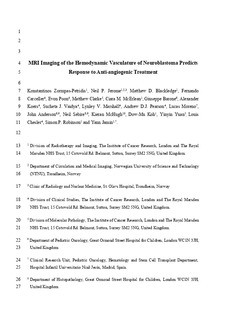| dc.contributor.author | Zormpas-Petridis, Konstantinos | |
| dc.contributor.author | Jerome, Neil Peter | |
| dc.contributor.author | Blackledge, Matthew D. | |
| dc.contributor.author | Carceller, Fernando | |
| dc.contributor.author | Poon, Evon | |
| dc.contributor.author | Clarke, Matthew | |
| dc.contributor.author | McErlean, Ciara | |
| dc.contributor.author | Barone, Guiseppe | |
| dc.contributor.author | Koers, Alexander | |
| dc.contributor.author | Vaidya, Sucheta | |
| dc.contributor.author | Marshall, Lynley | |
| dc.contributor.author | Pearson, Andrew D. J. | |
| dc.contributor.author | Moreno, Lucas | |
| dc.contributor.author | Anderson, John | |
| dc.contributor.author | Sebire, Neil | |
| dc.contributor.author | McHugh, Kieran | |
| dc.contributor.author | Koh, Dow-Mu | |
| dc.contributor.author | Yuan, Yinyin | |
| dc.contributor.author | Chesler, Louis | |
| dc.contributor.author | Robinson, Simon | |
| dc.contributor.author | Jamin, Yann | |
| dc.date.accessioned | 2019-10-14T12:27:49Z | |
| dc.date.available | 2019-10-14T12:27:49Z | |
| dc.date.created | 2019-07-25T17:24:30Z | |
| dc.date.issued | 2019 | |
| dc.identifier.issn | 0008-5472 | |
| dc.identifier.uri | http://hdl.handle.net/11250/2622001 | |
| dc.description.abstract | Childhood neuroblastoma is a hypervascular tumor of neural origin, for which antiangiogenic drugs are currently being evaluated; however, predictive biomarkers of treatment response, crucial for successful delivery of precision therapeutics, are lacking. We describe an MRI-pathologic cross-correlative approach using intrinsic susceptibility (IS) and susceptibility contrast (SC) MRI to noninvasively map the vascular phenotype in neuroblastoma Th-MYCN transgenic mice treated with the vascular endothelial growth factor receptor inhibitor cediranib. We showed that the transverse MRI relaxation rate R2* (second−1) and fractional blood volume (fBV, %) were sensitive imaging biomarkers of hemorrhage and vascular density, respectively, and were also predictive biomarkers of response to cediranib. Comparison with MRI and pathology from patients with MYCN-amplified neuroblastoma confirmed the high degree to which the Th-MYCN model vascular phenotype recapitulated that of the clinical phenotype, thereby supporting further evaluation of IS- and SC-MRI in the clinic. This study reinforces the potential role of functional MRI in delivering precision medicine to children with neuroblastoma. | nb_NO |
| dc.language.iso | eng | nb_NO |
| dc.publisher | American Association for Cancer Research | nb_NO |
| dc.title | MRI Imaging of the Hemodynamic Vasculature of Neuroblastoma Predicts Response to Antiangiogenic Treatment | nb_NO |
| dc.type | Journal article | nb_NO |
| dc.type | Peer reviewed | nb_NO |
| dc.description.version | acceptedVersion | nb_NO |
| dc.source.journal | Cancer Research | nb_NO |
| dc.identifier.doi | 10.1158/0008-5472.CAN-18-3412 | |
| dc.identifier.cristin | 1712761 | |
| dc.description.localcode | This is a post-peer-review, pre-copyedit version of an article published in [Cancer Research] Locked until 1.6.2020 due to copyright restrictions. The final authenticated version is available online at: http://dx.doi.org/10.1158/0008-5472.CAN-18-3412 | nb_NO |
| cristin.unitcode | 194,65,25,0 | |
| cristin.unitname | Institutt for sirkulasjon og bildediagnostikk | |
| cristin.ispublished | true | |
| cristin.fulltext | original | |
| cristin.qualitycode | 2 | |
